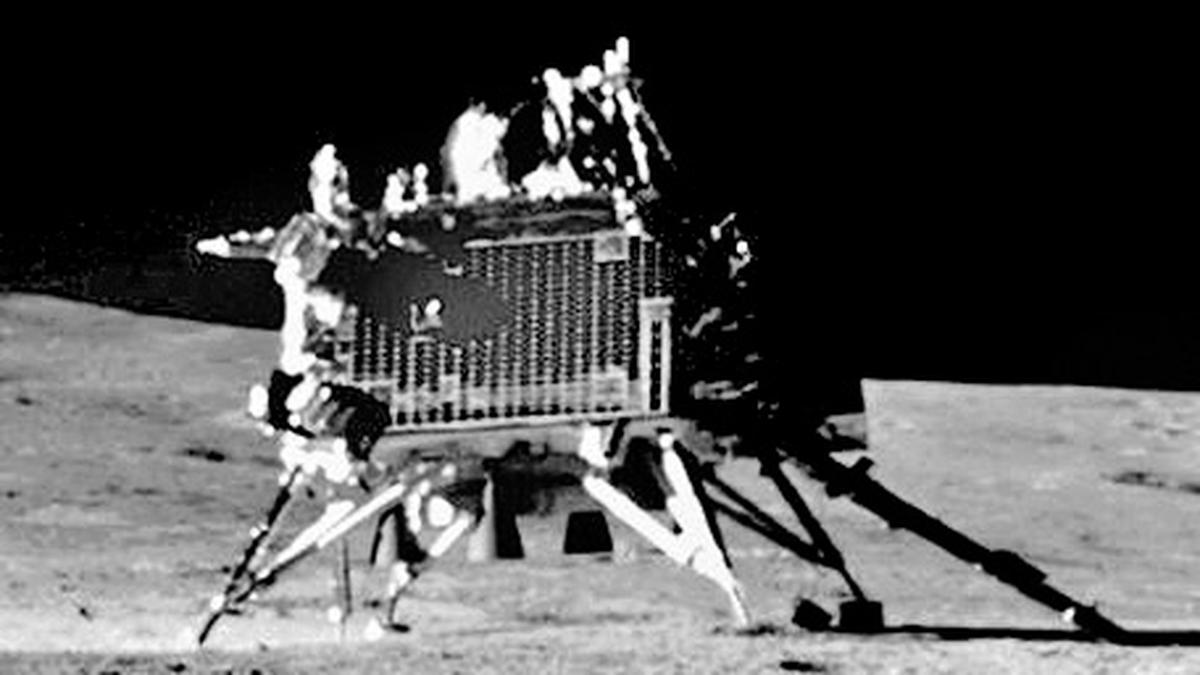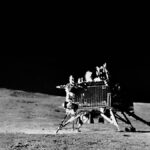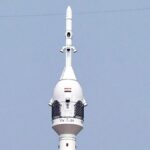Table of Contents
Exploring Mythology and Science: The Significance of Including References to Mythology in the Chandrayaan-3 Reading Module

The Vikram Lander of Chandrayaan-3 mission seen on the moon’s surface in this image clicked through Pragyan Rover’s navigation camera. | Photo Credit: ISRO
The Union Ministry of Education has defended the inclusion of references to mythology in the special reading module crafted by the National Council of Educational Research and Training (NCERT) on Chandrayaan-3 for schoolchildren.
In its clarification regarding news reports on this special module, the Ministry of Education said, “NCERT has meticulously crafted ten special modules on Chandrayaan-3 which offer a comprehensive overview of various facets of this mission, encompassing scientific, technological, cultural, and social aspects. Content within these modules has been thoughtfully designed to be interactive and engaging.”
Cultural Fabric
“The mythology and philosophy put forward ideas, and ideas lead to innovation and research. Numerous research studies emphasize that mythology plays an indispensable role in the cultural fabric of any country, including Bharat. Furthermore, the integration of culture into education not only fosters a profound understanding of a nation’s historical legacy but also bolsters creativity and problem-solving skills among students. It’s the whole gestalt of India’s association with sky and space,” the statement said.
Through this initiative, NCERT seeks to not only promote scientific temper but also instill a sense of pride, inspiration, and an understanding of our country’s achievements among the educational community and the public at large, the ministry said, defending the reading module.
To create awareness among students about the success of Chandrayaan-3, NCERT prepared a special reading module for schoolchildren and released it on October 17. In the explanation of this scientific achievement, the reading module had references to Vymaanika Shastra, Pushpakavimana in Indian mythology. However, this drew the ire of several educationists, students, and rationalists. The Hindu had reported on the same on October 25.
- The Union Ministry of Education has defended the inclusion of references to mythology in the special reading module crafted by the National Council of Educational Research and Training (NCERT) on Chandrayaan-3 for schoolchildren.
- Through this initiative, NCERT seeks to not only promote scientific temper but also instill a sense of pride, inspiration, and an understanding of our country’s achievements among the educational community and the public at large, the ministry said, defending the reading module.
- To create awareness among students about the success of Chandrayaan-3, NCERT prepared a special reading module for schoolchildren and released it on October 17.
The Significance of Including Mythology in the Chandrayaan-3 Reading Module
Recently, the National Council of Educational Research and Training (NCERT) released a special reading module on Chandrayaan-3 for schoolchildren, which sparked a debate due to its inclusion of references to mythology. The Union Ministry of Education has defended this decision, stating that mythology plays an indispensable role in a country’s cultural fabric and contributes to fostering creativity, problem-solving skills, and a sense of pride and inspiration among students.
Features and Objectives of the Reading Module
The reading module on Chandrayaan-3 meticulously crafted by NCERT offers a comprehensive overview of various facets of this mission. It encompasses scientific, technological, cultural, and social aspects, providing students with an interactive and engaging learning experience. The module aims not only to promote scientific temper but also to instill a deep understanding of India’s historical legacy and achievements in space exploration.
Effects and Benefits of Including Mythology
Integrating mythology into education has proven to have several positive effects on students. Research studies have highlighted that mythology fosters a profound understanding of a nation’s cultural heritage. It stimulates creativity and nurtures problem-solving skills by presenting diverse ideas and perspectives. Including references to mythology in the reading module helps students develop a sense of pride, inspiration, and curiosity about India’s association with the sky and space exploration.
Promoting Scientific Temper and Cultural Identity
The inclusion of mythology in the reading module serves the dual purpose of promoting scientific temper and preserving cultural identity. By blending scientific facts with mythical stories and concepts, students gain a holistic understanding of India’s rich scientific and cultural heritage. This approach inspires them to pursue scientific inquiry and research by appreciating the intersection of mythology and science.
Fun Fact: Vymaanika Shastra and Pushpakavimana
In the reading module, references were made to mythical concepts like Vymaanika Shastra and Pushpakavimana. Vymaanika Shastra is an ancient text that discusses various types of aircraft and flying machines. Pushpakavimana is a mythical vehicle mentioned in Hindu epics like the Ramayana. Including these fun and intriguing elements from mythology can capture the imagination of students and make the learning experience more enjoyable.
Pros and Cons of Including Mythology in Education
While the inclusion of mythology in education has its merits, it is important to consider some potential drawbacks as well.
Pros:
- Promotes a deeper understanding of cultural heritage
- Enhances creativity and problem-solving skills
- Inspires curiosity and interest in scientific exploration
- Encourages critical thinking and a multidimensional approach to learning
Cons:
- Possibility of confusion between mythological stories and scientific facts
- Challenge of balancing scientific accuracy with mythical interpretations
- May reinforce superstitions and pseudoscience if not approached critically
- Can lead to controversy and debate among educators and rationalists
Considering both the positive and negative aspects, it is crucial for educators to strike a balance when incorporating mythology into the curriculum. By providing proper context, encouraging critical thinking, and emphasizing the distinction between mythology and scientific facts, educators can harness the benefits of mythology while promoting a solid scientific foundation.
In conclusion, the inclusion of references to mythology in the Chandrayaan-3 reading module serves to engage students, promote a profound understanding of India’s cultural heritage, and inspire scientific curiosity. Mythology can be a valuable tool to stimulate creativity and problem-solving skills. However, it is essential to approach mythology in education with caution and ensure a balanced integration of scientific knowledge.
Mutiple Choice Questions
1. What is the purpose of the special reading module on Chandrayaan-3 prepared by NCERT?
a) To promote scientific temper and awareness among schoolchildren
b) To provide a comprehensive overview of various facets of the mission
c) To instill a sense of pride and inspiration in students
d) All of the above
Explanation: The special reading module aims to promote scientific temper, provide a comprehensive overview of the mission, and instill a sense of pride and inspiration among students.
2. Why did the Ministry of Education defend the inclusion of references to mythology in the reading module?
a) Mythology plays an indispensable role in the cultural fabric of any country.
b) Ideas from mythology lead to innovation and research.
c) Integration of culture in education fosters understanding, creativity, and problem-solving skills.
d) All of the above
Explanation: The Ministry of Education defended the inclusion of mythology, stating that it plays a role in the cultural fabric, leads to innovation and research, and fosters understanding, creativity, and problem-solving skills.
3. What drew criticism regarding the reading module?
a) Inclusion of mythology and references to Vymaanika Shastra and Pushpakavimana
b) Lack of scientific content and focus on cultural aspects
c) Insufficient information about Chandrayaan-3 mission
d) None of the above
Explanation: The reading module received criticism due to the inclusion of mythology and references to Vymaanika Shastra and Pushpakavimana, which drew ire from educationists, students, and rationalists.
Note: The detailed explanation provides context and clarifies the answers by referencing the information given in the provided text.
Brief Summary | UPSC – IAS
The Union Ministry of Education is defending the inclusion of mythology in a reading module on the Chandrayaan-3 mission for schoolchildren. The special module, crafted by the NCERT, aims to promote scientific interest and instill pride in India’s achievements. The ministry argues that mythology plays a significant role in the country’s cultural fabric and integrating it into education fosters creativity and problem-solving skills among students. The module, released on October 17, includes references to Vymaanika Shastra and Pushpakavimana from Indian mythology, which has drawn criticism from some educationists and rationalists.



